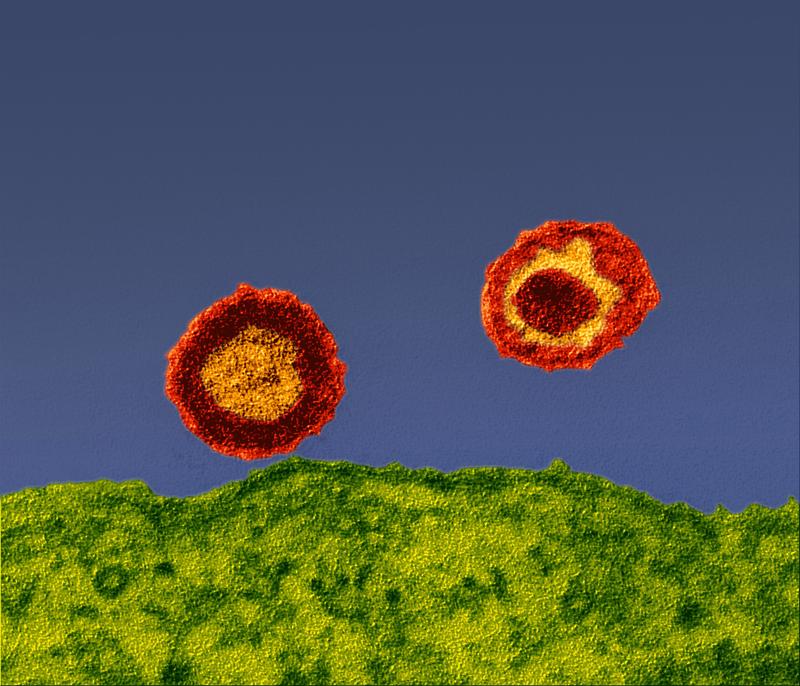

Two HI-Viruses outside the cell (green).
Source: PEI
Particular immune cells of the body called dendritic cells are in principle capable of recognizing HIV-1 as foreign invader. HIV-1, usually just referred to as HIV, causes the immune deficiency disease AIDS (acquired immunodeficiency syndrome).
Up to now, it has been unclear how the cells identify the virus as “foreign”. In collaboration with colleagues from the Sanford Burnham Medical Research Institute, La Jolla, California and the Icahn School of Medicine at Mount Sinai, New York, Dr Renate König, head of the research group “Cellular Aspects of Pathogen-Host Interactions” at the Paul-Ehrlich-Institut and her research team have discovered that polyglutamine binding protein 1 plays an important role in this mechanism.
They have demonstrated that this protein recognizes and binds to specific retroviral DNA. Although the genome of retroviruses, which also includes HIV, is normally present as RNA, it must first be transcribed into DNA, before it can integrate into the genome of the host cell. PQBP1 binds to the viral DNA and, moreover, binds to an additional protein called cyclic GMP-AMP synthase. It is not until this connection has been made that cGAS can activate a signal pathway which in turn activates the innate immune system and in turn, the specific immune system.
“With PQBP1, we have identified an important receptor which mediates the recognition of HIV by the cell and the immune system”, as Dr König described the research results. Up to now, it was assumed that cGAS alone was able to recognize foreign DNA. The researchers were now able to identify an additional important module in this mechanism.
Without PQBP1, dendritic cells are unable to recognize HIV. This was shown by Dr König and colleagues by investigating blood samples taken from patients suffering from Renpenning syndrome. In patients with this neurodegenerative disorder, the gene for PQBP1 has mutated and the protein is therefore not functional. The retroviral DNA of these patients’ immune cells could not bind to the protein so in turn cGAS signaling is not activated.
In principle, dendritic cells harbor the mechanism described here, which permits the activation of an immune response after the contact with retroviral DNA. Thus, the identified mechanism may guide potential treatment approaches. As Dr König explained the possible benefit from the findings: “Activation of this mechanism by an adjuvant could improve the immune response against HIV in the body and could thus also be used in immune therapy”.
Original publication
Yoh SM, Schneider M, Seifried J, Soonthomvacharin S, Akleh RE, Olivieri KC, De Jesus PD, Ruan de Castro CE, Ruiz PA, Germanaud D, des Portes V, García-Sastre A, König R, Chanda SK (2015): PQBP1 is a Proximal Sensor of HIV-1 DNA and Initiates cGAS-dependent Innate Immune Signaling.
Cell Jun 4 [Epub ahead of print].
The Paul-Ehrlich-Institut, the Federal Institute for Vaccines and Biomedicines, in Langen near Frankfurt/Main is a senior federal authority reporting to the Federal Ministry of Health (Bundesministerium für Gesundheit, BMG). It is responsible for the research, assessment, and marketing authorisation of biomedicines for human use and immunological veterinary medicinal products. Its remit also includes the authorisation of clinical trials and pharmacovigilance, i.e. recording and evaluation of potential adverse effects.
Other duties of the institute include official batch control, scientific advice and inspections. In-house experimental research in the field of biomedicines and life science form an indispensable basis for the manifold tasks performed at the institute.
The Paul-Ehrlich-Institut, with its roughly 800 members of staff, also has advisory functions nationally (federal government, federal states (Länder)), and internationally (World Health Organisation, European Medicines Agency, European Commission, Council of Europe etc.).
http://www.cell.com/cell/abstract/S0092-8674%2815%2900525-5 Publication (Abstract)
http://www.pei.de/EN/information/journalists-press/press-releases/2015/07-identi… This Press Release on the PEI-Website












